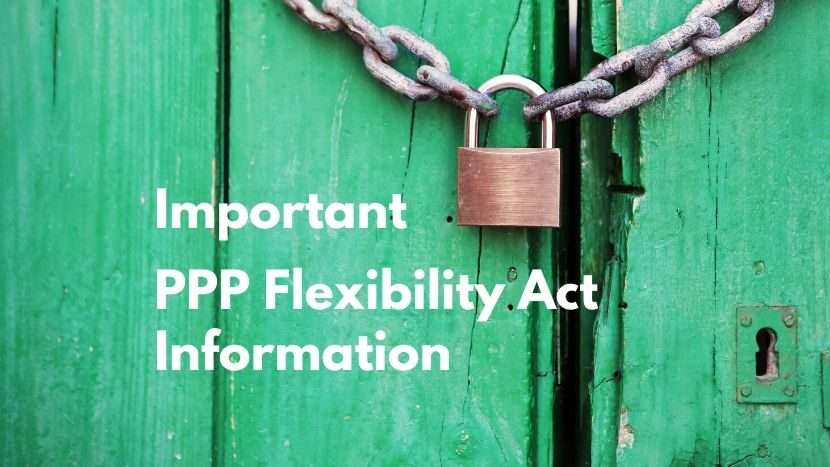PPP Flexibility Act Information

Between April 6 and today, Peoples Bank of Alabama (PBAL) funded almost $90 million in PPP loans - helping businesses make payroll to over 11,600 employees. Many of you have told us that this program has helped you get through the toughest economic conditions most of us have experienced in our lifetime. Almost 20% of the loans we made were to businesses who were new to the bank because their primary bank either didn’t participate or was too busy with other customers to respond. PBAL felt it was important to help as many businesses in our community as possible, believing in the old saying “a rising tide lifts all boats.” We appreciate the consideration that many of our new PPP customers are giving to moving their banking relationship to Peoples Bank of Alabama because they felt we were more responsive to their needs.
As you may have heard by now, President Trump signed a new bill on June 5th that made some significant changes (again!) to the PPP program. I’ve summarized these for you but I encourage you to check out the press release from the SBA to learn more about the changes:
| Timeframe: | You now have 24 weeks to spend all the money instead of 8. After spending it all, you can then submit the forgiveness request anytime between June 30 and December 31, 2020. |
| 75%/25%: | The rules regarding the amount required for payroll cost has changed from 75% to 60% and for other costs from 25% to 40%. Many of our customers have not been able to return employees to the payroll yet, so the extended time and lower percentage will be a big help. |
| Employees: | You now have until December 31, 2020 to bring your employment headcount back up to the level it was prior to February 15, 2020. Also, a prior rule change announced that you will not be held accountable for any employees that you fired for cause or offered to return to work and they declined. Just keep evidence of the good-faith offer to return and you’ll be fine. ONE IMPORTANT THING: there is no reason to hurry to submit your forgiveness request until you’ve had time to bring your employee headcount back up. Wait until you are able to meet that condition. |
| Repayment: | If you closed your loan before June 5, 2020, you are still under a 2-year repayment term; however, loans closed after June 5, 2020 get a 5-year repayment term on any balance that remains unforgiven. The rate remains 1%. |
Concerning the forgiveness process, PBAL has invested in a software partnership that we think will make this process easier than your initial application. We will send a secure email or letter in the next few weeks (prior to June 30, 2020) that will include instructions on how to establish a secure portal to complete an online forgiveness calculator and securely upload your receipts and documents. This will help you make sure everything is presented correctly and it will also help the bank to more efficiently process your request. Please be cautious of advertisements offering PPP applications or assistance to prepare your forgiveness package. The guidelines continue to evolve and no one knows how this process will look by June 30.
If you have specific questions about the forgiveness process consider these suggestions:
| Payroll Documents: | Hopefully the extended period to 24 weeks will make it easier for you to spend all the PPP loan proceeds on payroll expenses. Remember the limitation of $100,000 wage earners are capped at $15,384.62 in pay from PPP funds. If you have already met your maximum on certain employees, you can still use the remaining funds to pay other employees until the money is all gone. Documents required will be payroll reports (i.e. either payroll statements, paystubs, payroll tax filings reported i.e. Form 941, a spreadsheet with names and amounts, etc.) and evidence of payment (i.e. cancelled checks, bank statements showing the money came from PPP proceeds, etc.). Also, evidence of all insurance and benefit payments (invoices and evidence of payment). You can get a head-start by scanning these together as PDF files and save them in a folder called “Payroll Documents”. It would be helpful if you could create a spreadsheet with the total amount on the front and then provide the documentation to support that amount behind it. |
| Headcount: | The original instructions said to count all employees, whether full or part-time in your total. Be consistent with the methodology of how you calculated eligible employees at application to headcount at the end. |
| Expenses: | Be sure to keep accurate records of any expense you paid. Scan all similar bills together with evidence of payment (i.e., scan all power bills together with evidence of each payment). Save them as a PDF in a folder called “Utilities – Power.” The SBA has defined eligible business expenses as “business payments for a service for the distribution of electricity, gas, water, transportation, telephone, or internet access for which service began before February 15, 2020.” |
| Lease or Interest: | This will be the hardest to document because we will have to provide the lease or loan documents as support. If you have to, print out the front page and only the section that lists the monthly rent payment or the loan’s interest rate and balance. Then give us the details on how you calculated the forgiveness portion. Hopefully the extended timeframe may make it easier for you to spend all the money on payroll and you can avoid the hassle this use of funds may cause. |
| EIDL Advance: | If you applied and received an EIDL emergency advance (up to the $10,000 in “free money”), you must deduct that balance from your PPP forgiveness amount – If you used the EIDL emergency advance for the same purpose as the PPP loan, meaning you co-mingled the money to make payroll. If you used the money for other costs, you will repay that loan over the 30-year term as outlined.
|
The SBA asks you to keep all these records on file for six (6!) years, so be sure to either print or save this where you can access it should you ever need to in the future.
This has been a great program and has helped bridge the gap for many businesses who are now beginning to reopen. However, it has come with a lot of challenges and confusion. We continue to watch and listen and will let you know as things develop.
